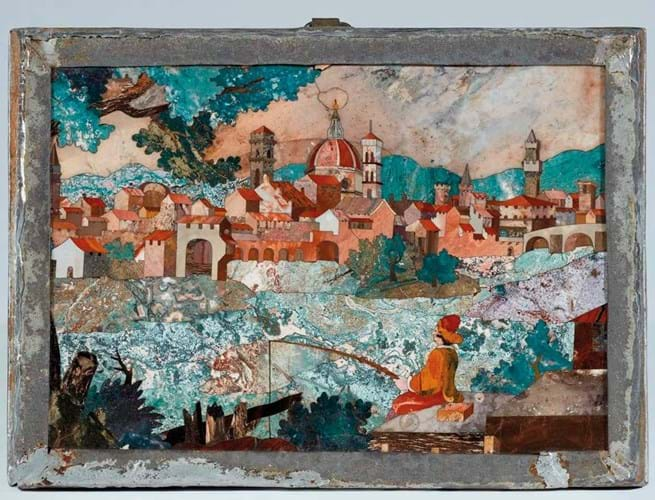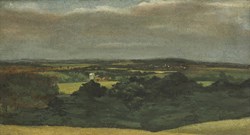
A great admirer of stone carving, cameos and the new technique of commesso di pietre dure, the emperor was also, like many of his contemporaries, convinced of the healing properties of gemstones.
According to Anna Maria Giusti’s Pietre Dure and the Art of Florentine Inlay (2006), the stone-cutting workshop Castrucci established operated for perhaps 30 years. His son Giovanni (d.1615) worked there from 1598 (he was made Kammer-Edelsteinschneider, royal jeweller, in 1610), as did fellow Italian lapidary Ottavio Miseroni (1567-1624).
Pictorial landscape panels fashioned in selected semi-precious stones were Castrucci’s stock in trade – and central to the importance of the Prague workshop in the history of commesso di pietre dure. He used the natural colours and patterns of the stones and a goldsmith’s knowledge of the glyphic arts to create pictures with remarkable spacial recession.
The earliest signed and dated work from the imperial workshop, a 7 x 10in (18 x 24cm) panel with a chapel and a bridge inscribed verso 1596, now resides in the Kunsthistorisches Museum in Vienna.
The panel offered by Lempertz in Cologne on November 2 came from a Belgian vendor. It had been in private ownership since 1965. The subject, picked out in jasper, agate and chalcedony on a painted slate panel, is unmistakably the Arno river with a view of Florence, giving rise to the suggestion that it was made either in Florence or Prague sometime between 1590-1600. Mounted in a leaded iron frame with soldered repairs, it measures 8 x 11in (20 x 27cm).
It is rare that a piece such as this is offered at auction. Christie’s sold another for £60,000 in London in 1998. Sotheby’s sold two as part of the Treasures sale in 2019 for £160,000 and £120,000.
Lempertz was able to offer this example at an attractive €30,000-40,000 guide and was rewarded with a hammer price of €230,000 (£205,350) plus 25% buyer’s premium. The winning bidder was the Princely Collections of Liechtenstein – owner of other works by the Castrucci family and perhaps the best-known example of pietra dura work: the Badminton cabinet it bought in 2004 at Christie’s for £19m.














